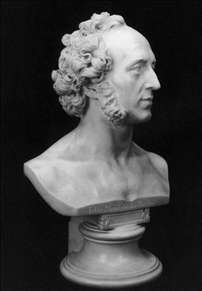German sculptor. From 1820 onwards, he studied at the Dresden Kunstakademie. In 1826 he moved to Berlin and joined the studio of Christian Daniel
Rauch, with whom he was to maintain a lifelong friendship. In 1828, for his relief Penelope and Odysseus, he received a scholarship to visit Italy. He did not begin his journey until 1830, since he was first required to take part in completing Rauch’s monument to Maximilian I Joseph in Munich. In the same period, he produced the figure of a potter (destroyed) for the gable decoration of the Munich Glyptothek.
After returning from Rome, Rietschel spent almost two years working with
Rauch, until taking up an appointment as professor at the Dresden Kunstakademie. His first important commission was the monument to Frederick Augustus I (1831-43; now in front of Japanisches Palais) for the Zwinger in Dresden, in artistic terms a transitional work. He also executed portal and pediment sculptures for the faade of the main building of the old University of Leipzig, and subsequently 12 reliefs on the theme of the cultural history of humanity for the main hall there. He went on to produce two tympana depicting Music and Tragedy (both destroyed in fire of 1869), as well as seated figures of the poets Schiller and Goethe and standing figures of the composers Gluck and Mozart for Gottfried Semper’s first Dresden Court Theatre (1838-41). He produced pediment sculptures for the Berlin Opera depicting personifications of Music, Dance and Dramatic Art (1844). In 1845 Frederick William IV commissioned him to produce a Pietà for the mausoleum of the Friedenskirche in Potsdam; this has been seen as his earliest work of equal significance to the sculpture of Rauch.
In his memorial sculpture, he gradually moved away from the Neoclassical tradition of his teacher and increasingly gave priority to naturalistic traits. His monument to playwright Lessing in Brunswick (1848-49) is thus one of the first representations of a writer of the previous century in contemporary clothing.
Rietshel acquired an international reputation, as can be seen by his honorary memberships of numerous European academies and many prizes. In 1858, the Prussian Order of Merit for science and the arts was conferred on him.
If you want write a review , you have to be registered.
